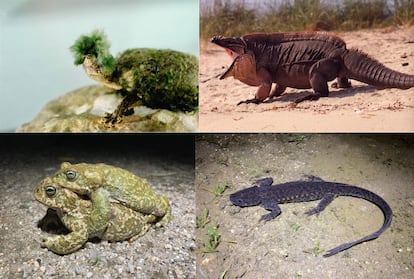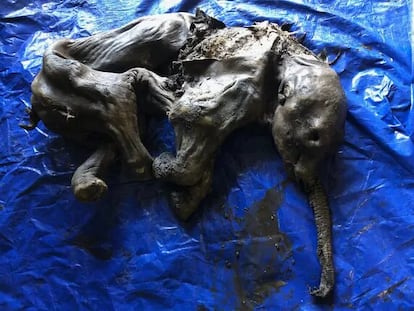Cold-blooded animals that never seem to age
Two research studies covering more than 100 species of amphibians and reptiles reveal that turtles and salamanders have aging rates close to zero

Researchers from Spain’s National Museum of Natural Science (Museo Nacional de Ciencias Naturales - MNCN) have been regularly visiting two ponds in the Guadarrama mountain range (central Spain) since 2009. They capture, tag, and release all the amphibians (toads, frogs, and newts) they can catch. Their monitoring of thousands of specimens for over 10 years has enabled them to estimate how long these animals live and how they age in the wild. Their life expectancy is longer than previously thought and the aging process in some species is extraordinarily slow. According to two studies recently published in Science, most of the so-called cold-blooded animals exhibit these same characteristics.
Evolutionary theories about aging predict that all living organisms weaken and deteriorate with age in a process called senescence that ends in death. Mammals, the most extensively studied class of animals, peak in their development when they reach sexual maturity. Once the vital mission of ensuring the survival of the species has been accomplished, these animals, including humans, begin to weaken and the aging process accelerates. This pattern was thought to be common to the entire animal kingdom, including reptiles and amphibians. Until now.
The ponds of Guadarrama are home to a sizeable population of newts called “gallipatos” (Pleurodeles waltl). Endemic to the Iberian Peninsula and North Africa, they are the largest amphibians found in Europe. MNCN researcher Íñigo Martínez-Solano, co-author of one of the studies, said that in 2009, they tagged and classified several of these gallipatos as adults. “This spring [2022], we captured them again, which could mean that they live more than 15 years,” he said. Some specimens in captivity have lived up to 20 years, but survival in the wild is another matter, and life expectancy is always much lower.
Determining true life expectancies is one of the main contributions of the first study, which involved more than 100 researchers who spent years and even decades studying reptile and amphibian species. These species are ectothermic animals (like fish), meaning they do not generate internal heat, which is why they are called cold-blooded. Many biologists say that ectothermy produces a low metabolic rate (although the inverse may be true–a low metabolic rate produces ectothermy). The thermoregulatory hypothesis maintains that these animals live longer than mammals and birds of the same size, and have much lower aging rates.
But the reality is much more complex. Indeed, 26 of the 30 longest-living species are ectotherms. It’s also true that 80% of the reptiles and amphibians studied have lower aging rates than humans. However, of the 107 wild populations studied, the aging rates and life expectancies of ectotherms were found to be highly variable in 77 of these populations. There are species of ectotherms that fall well above and some that fall below the known aging rates for endotherms (mammals, birds, and some fish) of similar size. This suggests that the way an animal regulates its temperature (cold blood versus warm blood) is not necessarily a determinant of its aging rate or longevity. David Miller, an ecologist at Pennsylvania State University (USA) and senior author of the study, said, “We did not find support for the idea that a lower metabolic rate means that ectotherms age more slowly. That relationship is only true for turtles, which points to their uniqueness among ectotherms.”
The widespread belief that turtles live a long time is confirmed by this study. In fact, several species, such as those found in the Galapagos, live well beyond 100 years. However, according to a second study published in Science, the average longevity of 52 different tortoise species is 39 years, significantly lower than the average 137 years of the tuatara, an iguana-like reptile endemic to New Zealand.
But what is really special about both terrestrial and marine turtles, is their very low aging rates. If conditions are right, some can even experience negative rates. Once mammals reach sexual maturity, the risk of mortality increases with age. But this is not the case for many reptiles and amphibians, and also not true for almost all turtles. By studying data stored in Species360, a database of information provided by zoos and aquariums around the world, the authors of the second study found that the reptiles with the lowest aging rate are turtles–it’s almost zero. That is, the probability of dying remains stable.
Turtles grow like all animals and devote a lot of energy to development. However, when they reach sexual maturity, turtles continue to grow while other animals stopFernando Colchero, researcher, University of Southern Denmark
Fernando Colchero, a researcher at the University of Southern Denmark, is the co-author of the second study that focused on turtles. “Recent theory suggests that aging is the result of a process that weighs where to put energy when sexual maturity is reached–survival or reproduction. Some animals devote most of their energy to reproduction and produce lots of offspring, but die very young. Others are extremely long-lived, and devote less energy to reproduction. Instead, they distribute it over time. Examples include humans and elephants. But turtles don’t fit this pattern,” said Colchero. “Turtles grow like all animals and devote a lot of energy to development. However, when they reach sexual maturity, turtles continue to grow while other animals stop.” This means that they are being able to devote sufficient energy to reproduction and also to repairing physiological damage.
Turtles are even capable of reversing senescence. When comparing the longevity and aging rates of turtles in zoos with those living in the wild, the former were observed to live longer and have much lower aging rates. “This means that they have a very flexible ability to regulate aging,” said Colchero. He compares this aging process with other living beings such as primates and humans. “When primates are placed in a different environmental context, they experience lower infant and juvenile mortality, but the aging rate does not clearly decrease. But in turtles, it does.”
Colchero says that turtles are compelling us to reformulate our evolutionary theories of aging. “Since current theories can partially explain this, we must reformulate our ideas so we can identify previously unknown mechanisms.”
One possible explanation, not excluding others, is that their efficiency in repairing damage has to do with the energy they devote to their offspring. Unlike mammals and birds, parental care is very rare among reptiles and amphibians. They compensate by producing many offspring over time in order to achieve the vital objective–to pass on their genes to the next generation. But Colchero acknowledges that further studies at the physiological and molecular levels are needed to unravel the mystery.
Tu suscripción se está usando en otro dispositivo
¿Quieres añadir otro usuario a tu suscripción?
Si continúas leyendo en este dispositivo, no se podrá leer en el otro.
FlechaTu suscripción se está usando en otro dispositivo y solo puedes acceder a EL PAÍS desde un dispositivo a la vez.
Si quieres compartir tu cuenta, cambia tu suscripción a la modalidad Premium, así podrás añadir otro usuario. Cada uno accederá con su propia cuenta de email, lo que os permitirá personalizar vuestra experiencia en EL PAÍS.
¿Tienes una suscripción de empresa? Accede aquí para contratar más cuentas.
En el caso de no saber quién está usando tu cuenta, te recomendamos cambiar tu contraseña aquí.
Si decides continuar compartiendo tu cuenta, este mensaje se mostrará en tu dispositivo y en el de la otra persona que está usando tu cuenta de forma indefinida, afectando a tu experiencia de lectura. Puedes consultar aquí los términos y condiciones de la suscripción digital.
More information
Últimas noticias
Miguel Alandia, the artist whose murals were saved by miners under Bolivia’s military rule
What are men searching for (and running from) when they go on a retreat?
Why we lost the habit of sleeping in two segments and how that changed our sense of time
Meet Fly, the guardian of the hawksbill sea turtles on Santa Catalina Island
Most viewed
- The Florida Keys tourist paradise is besieged by immigration agents: ‘We’ve never seen anything like this’
- Chevy Chase, the beloved comedian who was a monster off camera: ‘Not everyone hated him, just the people who’ve worked with him’
- December Social Security and SSI payments: Dates, double checks and the 2026 COLA increase
- Liset Menéndez de la Prida, neuroscientist: ‘It’s not normal to constantly seek pleasure; it’s important to be bored, to be calm’
- The low-cost creative revolution: How technology is making art accessible to everyone











































